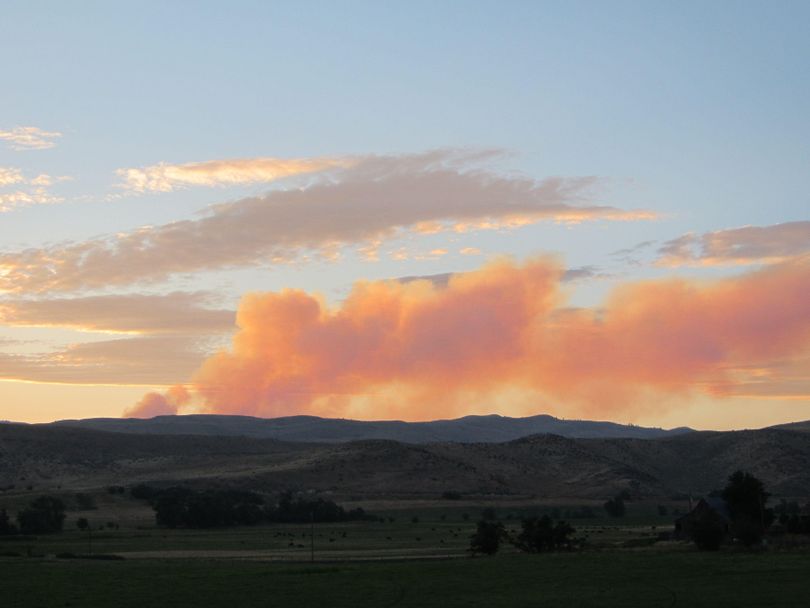Lightning touches off three new fires, even as wildfire season starts to wind down

Lightning touched off three new, large fires in Idaho, a reminder wildfire season is continuing even as crews finally get some help from shorter days, lower temperatures and higher humidity that accompany fall's arrival, the AP reports. Meanwhile, massive blazes that earlier burned in south-central Idaho are nearly contained, and the nation's 2013 fire season is slowly grinding to a halt, with favorable weather across Idaho and the West helping keep flames in check.
The new fires include the 3,000-acre Hells Canyon fire 15 miles northwest of Weiser; the nearby 1,500-acre Raft Fire; and the 993-acre Kelley Fire seven miles southeast of Featherville. Meanwhile, the huge Beaver Creek fire that earlier threatened Sun Valley and Ketchum is now 95 percent contained; and the LIttle Queens fire that threatened Atlanta is 20 percent contained.
The nation actually is on track to have the second-lowest number of square miles burned by wildfires in a decade, AP reporter John Miller reports, largely because rain in states like Florida, Oklahoma and Nebraska kept big, early-season grass fires to a minimum. So far, only 3.7 million acres had burned across the United States through Friday, about 60 percent of average. In the West, however, fire activity has been average or above-average. Click below for his full report.
3 new ID fires start while others nearly contained
By JOHN MILLER, Associated Press
BOISE, Idaho (AP) — Lightning touched off three new, large fires in Idaho, a reminder wildfire season is continuing even as crews finally get some help from shorter days, lower temperatures and higher humidity that accompany fall's arrival.
Meanwhile, firefighters have nearly surrounded two massive, south-central Idaho blazes, the Beaver Creek and Elk Complex fires. These fires once threatened communities including Sun Valley and kept air tankers, helicopters and scores of hand crews busy in the state for much of the month.
Just weeks ago, Beaver Creek, at more than 170 square miles in all, was bearing down on the towns of Hailey, Ketchum and Sun Valley, while the 200-square-mile Elk Complex destroyed dozens of cabins and vacation homes in Falls Creek, a little community along the Boise River's Anderson Ranch Reservoir about 50 miles east of Boise.
Among Idaho's new blazes, the Raft Fire along the Snake River's Brownlee Reservoir 20 miles north of Midvale has expanded to about 2 square miles by Friday, while the nearby Hells Canyon Fire was at 5 square miles.
Structures are threatened in Sturgill Creek, a popular spot for all-terrain vehicle riders and mule-deer hunters. The area has a nearby mountaintop fire lookout, a historic mining site, a vacant tourist lodge and Idaho Power Co. facilities.
The blaze spread quickly with the wind through grass, brush and timber-filled draws.
The Raft and Hells Canyon fires "burned actively throughout the night," Payette National Forest spokesman Brian Harris in McCall said Friday.
"They jumped the containment lines we did get in yesterday," he said. "We're experiencing a fair amount of wind, sustained 25 miles an hour, and that's making them grow."
Harris warned recreationists at the forest to check with officials about fire-related closures for the coming Labor Day weekend.
Fire managers at the National Interagency Fire Center in Boise said they've gotten some good news this week amid one of the most dramatic fire years.
After previously downgrading the nation's fire priority status by one notch, officials announced at Thursday morning's staff meeting that there were no outstanding orders for crews to be dispatched to the latest hotspot. That's a distinct departure from the middle of the month, when there weren't enough resources to go around, said Robyn Broyles, NIFC spokeswoman.
And it's a welcome sign that the 2013 fire season is slowly grinding to a halt, with favorable weather across Idaho and the West helping keep flames in check.
"The weather has started to help us out," Broyles said. "Areas that have had fire activity in the last few weeks are getting ahold of those fires and are being able to supply resources to other areas that need them."
Given media coverage of Idaho's Beaver Creek Fire and the 300-square-mile Rim Fire burning near Yosemite National Park in eastern California, Broyles conceded it may seem hard to believe the nation actually is on track to have the second-lowest number of square miles burned by wildfires in a decade.
That's largely because rain in states like Florida, Oklahoma and Nebraska kept big, early-season grass fires to a minimum. So far, only 3.7 million acres had burned across the United States through Friday, about 60 percent of average.
In the West, however, fire activity has been average or above-average, with flames garnering attention after threatening or destroying homes in high-profile areas of Idaho, Utah, Colorado, Arizona and California.
And 31 firefighters have died so far, including 19 in Arizona's Yarnell Hill Fire on June 30. On average, 17 firefighters die annually, according to NIFC statistics.
"You can measure it in numbers and acres," Broyles said, of the 2013 fire year. "But when you look at the human cost, that's why this has been such a dramatic — and tragic — year."
Copyright 2013 The Associated Press.
